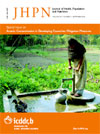
|
The Journal of Health, Population and Nutrition
icddr,b
ISSN: 1606-0997
EISSN: 1606-0997
Vol. 29, No. 2, 2011, pp. 81-91
|
 Bioline Code: hn11011
Bioline Code: hn11011
Full paper language: English
Document type: Comment
Document available free of charge
|
|
|
The Journal of Health, Population and Nutrition, Vol. 29, No. 2, 2011, pp. 81-91
| en |
Where There Are (Few) Skilled Birth Attendants
Prata, Ndola; Passano, Paige; Rowen, Tami; Bell, Suzanne; Walsh, Julia & Potts, Malcolm
Abstract
Recent efforts to reduce maternal mortality in developing countries have focused primarily on two longterm aims: training and deploying skilled birth attendants and upgrading emergency obstetric care facilities. Given the future population-level benefits, strengthening of health systems makes excellent strategic sense but it does not address the immediate safe-delivery needs of the estimated 45 million women who are likely to deliver at home, without a skilled birth attendant. There are currently 28 countries from four major regions in which fewer than half of all births are attended by skilled birth attendants. Sixty-nine percent of maternal deaths in these four regions can be attributed to these 28 countries, despite the fact that these countries only constitute 34% of the total population in these regions. Trends documenting the change in the proportion of births accompanied by a skilled attendant in these 28 countries over the last 15-20 years offer no indication that adequate change is imminent. To rapidly reduce maternal mortality in regions where births in the home without skilled birth attendants are common, governments and community-based organizations could implement a cost-effective, complementary strategy involving health workers who are likely to be present when births in the home take place. Training community-based birth attendants in primary and secondary prevention technologies (e.g. misoprostol, family planning, measurement of blood loss, and postpartum care) will increase the chance that women in the lowest economic quintiles will also benefit from global safe motherhood efforts.
Keywords
Cross-sectional studies; Delivery; Maternal health services; Maternal mortality; Misoprostol; Postpartum haemorrhage; Skilled birth attendants; Traditional birth attendants
|
| |
© Copyright 2011 Journal of Health Population and Nutrition.
Alternative site location: http://www.jhpn.net
|
|
